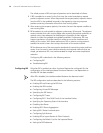
72 CHAPTER 5: IP ROUTING PROTOCOL OPERATION
The whole process of RIP startup and operation can be described as follows:
1 If RIP is enabled on a router for the first time, the router broadcasts a request
packet to adjacent routers. When they receive the request packet, adjacent routers
(on which RIP is also enabled) respond to the request by returning response
packets containing information about their local routing tables.
2 After receiving the response packets, the router that sent the request modifies its
own routing table.
3 RIP broadcasts its routing table to adjacent routers every 30 seconds. The adjacent
routers maintain their own routing tables after receiving the packets and elect an
optimal route, then advertise the modification information to their adjacent
network to make the updated route globally available. Furthermore, RIP uses
timeout mechanism to handle timed-out routes to ensure the timeliness and
validity of the routes. With these mechanisms, RIP, an interior routing protocol,
enables the router to learn the routing information of the entire network.
RIP has become one of the most popular standards of transmitting router and host
routes. It can be used in most campus networks and regional networks that are
simple, yet extensive. RIP is not recommended for larger and more complicated
networks.
Configuring RIP is described in the following sections:
■ Configuring RIP
■ Troubleshooting RIP
Configuring RIP Only after RIP is enabled can other functional features be configured. But the
configuration of the interface-related functional features is not dependent on
whether RIP has been enabled.
After RIP is disabled, the interface-related features also become invalid.
The RIP configuration tasks are described in the following sections:
■ Enabling RIP and Entering the RIP View
■ Enabling the RIP Interface
■ Configuring Unicast RIP Messages
■ Specifying the RIP Version
■ Configuring RIP Timers
■ Configuring RIP-1 Zero Field Check of the Interface Packet
■ Specifying the Operating State of the Interface
■ Disabling Host Route
■ Enabling RIP-2 Route Aggregation
■ Setting RIP-2 Packet Authentication
■ Configuring Split Horizon
■ Enabling RIP to Import Routes of Other Protocols
■ Configuring the Default Cost for the Imported Route
■ Setting the RIP Preference


















